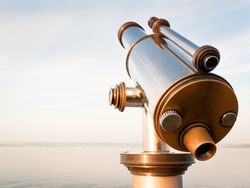
All mirrors essentially work the same way, but the shape of the glass can have a dramatic impact on how the reflected image looks. While they’re available in a variety of shapes and sizes, all fall into three basic categories: plane, convex, and concave. Each of these shapes has different properties that make them ideal for different applications, from home use to industrial processes requiring high degrees of precision.
The 3 Types of Mirrors
1. Plane
Plane mirrors are the most familiar type of reflective surface, found in bathrooms and vanity tables around the world. Due to their flat shape, these they reflect light with very little change to the original image. Objects in a plane mirror seem to be the same size relative to one another as their real-world counterparts, although the image does appear horizontally inverted.
2. Concave
Concave mirrors feature a curved surface, with edges that are closer to the reflected object than the center. The curve in the glass provides a focal point, which determines how the final image appears. This type is often used in flashlights and lamps to reflect and enhance light, but they also create enlarged images that make them useful for shaving mirrors and dentist’s tools.
3. Convex
 Convex is the opposite of concave, with a center that bulges toward the object being reflected. This shape creates a smaller reflection that will appear vertically inverted if the mirror is held a few feet away from the viewer. Most often, this shape is used in sideview mirrors, magnifying glasses, and telescopes.
Convex is the opposite of concave, with a center that bulges toward the object being reflected. This shape creates a smaller reflection that will appear vertically inverted if the mirror is held a few feet away from the viewer. Most often, this shape is used in sideview mirrors, magnifying glasses, and telescopes.
Furniture City Glass & Mirror is the leading supplier of custom glass in High Point, NC, serving homeowners and businesses throughout the Triad Area with high-quality materials. They have an extensive inventory and the expertise to cut customized materials to fit your space and application. Learn more about their services online, or call (336) 841-5333 to request a quote.
About the Business
Have a question? Ask the experts!
Send your question

